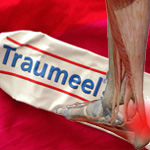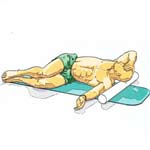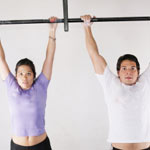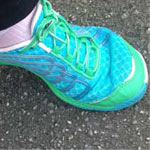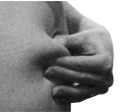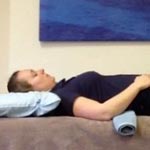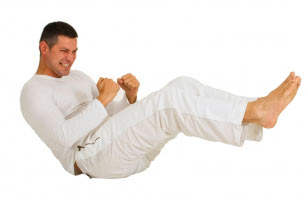
“Image courtesy of Ambro / FreeDigitalPhotos.net”
Sometimes I am asked why I do not include crunches in my Fab Abs group fitness classes. I have done considerable research on the best and safest ways to strengthen your core and this post should explain my reasons for omitting them and exactly what my class is designed to achieve.
So are crunches bad for you?
Crunches aren’t necessarily bad; they’re just terribly overused. Doing some crunches is fine when done on a Swiss ball that supports going through the full range of movement, letting the rectus abdominus (six pack) stretch on extension.
The main job of your abs is not to look good, but to switch on at the right time to support the spine in complex daily movement or sports and protect it from injury.
Save your posture and your back.
I generally find that most people have already got an imbalance between trunk flexors (the muscles that bend the body forward) and trunk extensors (the muscles that bend the body backward) displaying poor posture because of their tight upper abs, a depressed ribcage, forward head, rounded upper back and shoulders combined with loose lower abs (protruding belly below the navel). It isn’t very flattering as well as compromising organs, lung function and over all stability in standing and movement.

Yes I have exaggerated the posture but this way you can actually tell what I am talking about.
We need to take into consideration that we are in flexion all day long, slumped into chairs and hunched over steering wheels – to then lie down on the floor to do crunches just accumulates more flexion.
I like to add plenty of extension/ opening up the chest and activating the spinal erectors to re-program the body to be tall.
We need functional movement training to make the body stronger and more able to carry out the daily tasks and the sports we play. Most common abdominal floor exercises do little to enhance function or trigger automatic activation of the entire set of small, deep core stabilisers.
Crunching all pain, no gain?
Performing excessive sit-ups or crunches puts stress on the physical structures of the body – the bones, ligaments, and tendons, especially of the neck and lower back, making them a fast way to getting chronic pain or muscle tension problems.
I cannot live with the thought of possibly causing someone pain by teaching something that is harmful and I do not believe in.
Interestingly I have had feedback from many people that they prefer my new FAB ABS format because their necks do not hurt during the class. Bonus.

Don’t support muscle imbalances!
Overexposure to sit-ups and leg lowering exercises, which are commonly used in abdominal workouts lead to excessive strength and tightening of the psoas group. These deep hip flexors when too tight can be contributors to lower back pain.
The psoas group is hard to release through stretching which means prevention is better than dealing with accumulated tension and related chronic pain.
But how can I flatten my abs?
You are better off focusing your effort on strengthening your deep core muscles which act like a natural corset, pulling in the waist and stabilising your spine so you can exert power with your big outer muscle without getting hurt.
I aim to build a functional, flattening deep abdominal wall (TVA), which acts as the corset that is needed to eliminate the paunch. A dysfunctional tummy wall lets the organs droop leaving them unsupported. This usually shows up as a distended tummy or paunch.
I am sure you can think of someone that should read this article, please share it.

Image courtesy of stockimages/ FreeDigitalPhotos.net
What about that six pack?
Really, flat abs are made in the kitchen not in the gym.
It is crucial to eat foods for your metabolic type that do not cause you bloating, pain and intestinal inflammation that switches off your abs. Check out my previous post on the why and how of the pooch belly.
Not managing your stress will leave you fighting a losing battle with your love handles. Stress causes the body to store fat around the mid section to prepared for difficult times.
Read my article I didn’t like tai chi to learn more about all the different stressors that affect your body composition/ fat storing.
You need to decide how important having a six-pack is to you. It takes dedication and smart training/ living to reduce overall body fat to the percentage where the abdominal muscles will show. Is it worth it?
I say no, I prefer to have a flat “normal” tummy and instead use my time and energy to make a difference in the world.
No equipment needed
Because we do not have the luxury of a Swiss ball or wobble board for our class I have researched exercises that challenge the righting reflex by creating gentle turbulence by movement the limbs in different patterns.
The instability created through the movement of the arms and legs as well as standing on one leg helps trigger lazy core muscle to activate. This is a natural reflex that the body has to protect itself from injury, falling over would cause trauma; generally a healthy body does its best to avoid getting hurt.
You wonder why some people do still get injured? Because they ignore the warning signals of the body until it is too late.
Lower abs are your back’s insurance
My aim is to provide functional training that considers the demands of the real world and has a greater neuromuscular carry over to activities such as sports and athletics. Strength and stability when using the arms and legs comes from the midsection your trunk muscles – I call it the centre of the universe.
Progression from high reps for endurance to weighted low reps for growing the size.
Let’s flatten the abs by re-activating the deep abdominal wall (TVA). Once we have enough endurance (12-30reps/ 3sets) to support our favourite activities we can go in and work on making the six pack bigger.
There are many advanced exercises that utilise additional weight like a cable tower, dumbbells or medicine balls to challenge the abs with fewer repetitions which promotes hypertrophy. It is crucial to build up to these exercises to avoid injury.
In my experience rushing ahead to reach a goal generally causes huge setbacks. Slow and steady does it when it come to building a strong, functioning beautiful body.
If you are curious about how I help my clients achieve a fully functional core that looks amazing and makes them feel great, get in touch for more personal support.
I offer holistic personal training and nutrition and lifestyle coaching locally in Leeds, West Yorkshire, UK.
You live somewhere else? No problem I offer online coaching too.
Did I leave you with an open question send me an email and I will personally get back to you.
I look forward to getting you off the crunches 😉


